2007 CHEVROLET IMPALA trailer
[x] Cancel search: trailerPage 289 of 460
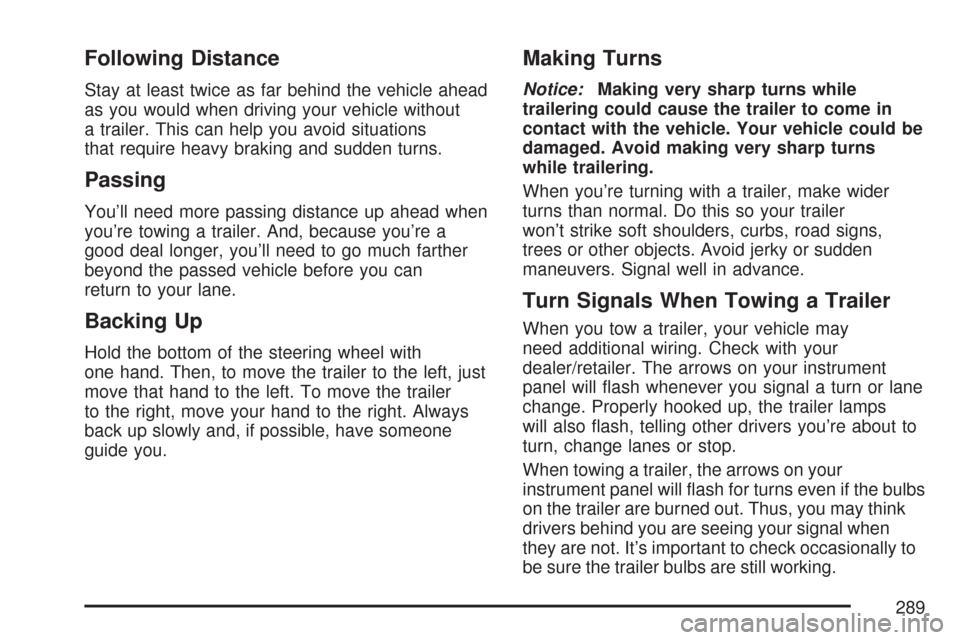
Following Distance
Stay at least twice as far behind the vehicle ahead
as you would when driving your vehicle without
a trailer. This can help you avoid situations
that require heavy braking and sudden turns.
Passing
You’ll need more passing distance up ahead when
you’re towing a trailer. And, because you’re a
good deal longer, you’ll need to go much farther
beyond the passed vehicle before you can
return to your lane.
Backing Up
Hold the bottom of the steering wheel with
one hand. Then, to move the trailer to the left, just
move that hand to the left. To move the trailer
to the right, move your hand to the right. Always
back up slowly and, if possible, have someone
guide you.
Making Turns
Notice:Making very sharp turns while
trailering could cause the trailer to come in
contact with the vehicle. Your vehicle could be
damaged. Avoid making very sharp turns
while trailering.
When you’re turning with a trailer, make wider
turns than normal. Do this so your trailer
won’t strike soft shoulders, curbs, road signs,
trees or other objects. Avoid jerky or sudden
maneuvers. Signal well in advance.
Turn Signals When Towing a Trailer
When you tow a trailer, your vehicle may
need additional wiring. Check with your
dealer/retailer. The arrows on your instrument
panel will �ash whenever you signal a turn or lane
change. Properly hooked up, the trailer lamps
will also �ash, telling other drivers you’re about to
turn, change lanes or stop.
When towing a trailer, the arrows on your
instrument panel will �ash for turns even if the bulbs
on the trailer are burned out. Thus, you may think
drivers behind you are seeing your signal when
they are not. It’s important to check occasionally to
be sure the trailer bulbs are still working.
289
Page 290 of 460

Driving On Grades
Reduce speed and shift to a lower gearbefore
you start down a long or steep downgrade. If you
don’t shift down, you might have to use your
brakes so much that they would get hot and no
longer work well.
On a long uphill grade, shift down and reduce
your speed to around 45 mph (70 km/h) to reduce
the possibility of engine and transmission
overheating.
Notice:When the outside temperature is
above 100° F (38° C) and/or there is a steep,
continuous grade, the recommended speed
when towing is 55 mph (88 km/h) or less.
Extended higher than normal engine and
transmission temperatures may damage your
vehicle.
If you have overdrive, you may want to drive in
THIRD (3) instead of DRIVE (D).
Parking on Hills
{CAUTION:
You really should not park your vehicle,
with a trailer attached, on a hill. If
something goes wrong, your rig could
start to move. People can be injured, and
both your vehicle and the trailer can be
damaged.
But if you ever have to park your rig on a hill,
here’s how to do it:
1. Apply your regular brakes, but don’t shift into
PARK (P) yet.
2. Have someone place chocks under the trailer
wheels.
3. When the wheel chocks are in place, release
the regular brakes until the chocks absorb
the load.
4. Reapply the regular brakes. Then apply your
parking brake, and then shift to PARK (P).
5. Release the regular brakes.
290
Page 291 of 460

When You Are Ready to Leave After
Parking on a Hill
1. Apply your regular brakes and hold the pedal
down while you:
start your engine,
shift into a gear, and
release the parking brake.
2. Let up on the brake pedal.
3. Drive slowly until the trailer is clear of
the chocks.
4. Stop and have someone pick up and store
the chocks.
Maintenance When Trailer Towing
Your vehicle will need service more often when
you’re pulling a trailer. See the Maintenance
Schedule for more on this. Things that are
especially important in trailer operation are
automatic transmission �uid (don’t over�ll),
engine oil, drive belts, cooling system and brake
system. Each of these is covered in this manual,
and the Index will help you �nd them quickly.
If you’re trailering, it’s a good idea to review
this information before you start your trip.
Check periodically to see that all hitch nuts and
bolts are tight.
Engine Cooling When Trailer Towing
Your cooling system may temporarily overheat
during severe operating conditions. SeeEngine
Overheating on page 323.
291
Page 318 of 460
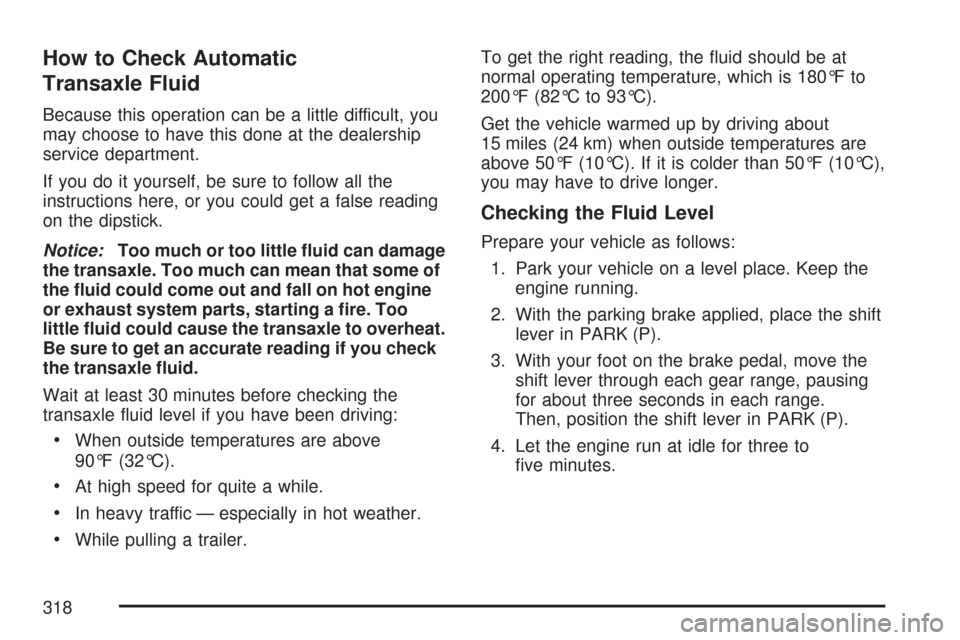
How to Check Automatic
Transaxle Fluid
Because this operation can be a little difficult, you
may choose to have this done at the dealership
service department.
If you do it yourself, be sure to follow all the
instructions here, or you could get a false reading
on the dipstick.
Notice:Too much or too little �uid can damage
the transaxle. Too much can mean that some of
the �uid could come out and fall on hot engine
or exhaust system parts, starting a �re. Too
little �uid could cause the transaxle to overheat.
Be sure to get an accurate reading if you check
the transaxle �uid.
Wait at least 30 minutes before checking the
transaxle �uid level if you have been driving:
When outside temperatures are above
90°F (32°C).
At high speed for quite a while.
In heavy traffic — especially in hot weather.
While pulling a trailer.To get the right reading, the �uid should be at
normal operating temperature, which is 180°F to
200°F (82°C to 93°C).
Get the vehicle warmed up by driving about
15 miles (24 km) when outside temperatures are
above 50°F (10°C). If it is colder than 50°F (10°C),
you may have to drive longer.
Checking the Fluid Level
Prepare your vehicle as follows:
1. Park your vehicle on a level place. Keep the
engine running.
2. With the parking brake applied, place the shift
lever in PARK (P).
3. With your foot on the brake pedal, move the
shift lever through each gear range, pausing
for about three seconds in each range.
Then, position the shift lever in PARK (P).
4. Let the engine run at idle for three to
�ve minutes.
318
Page 325 of 460
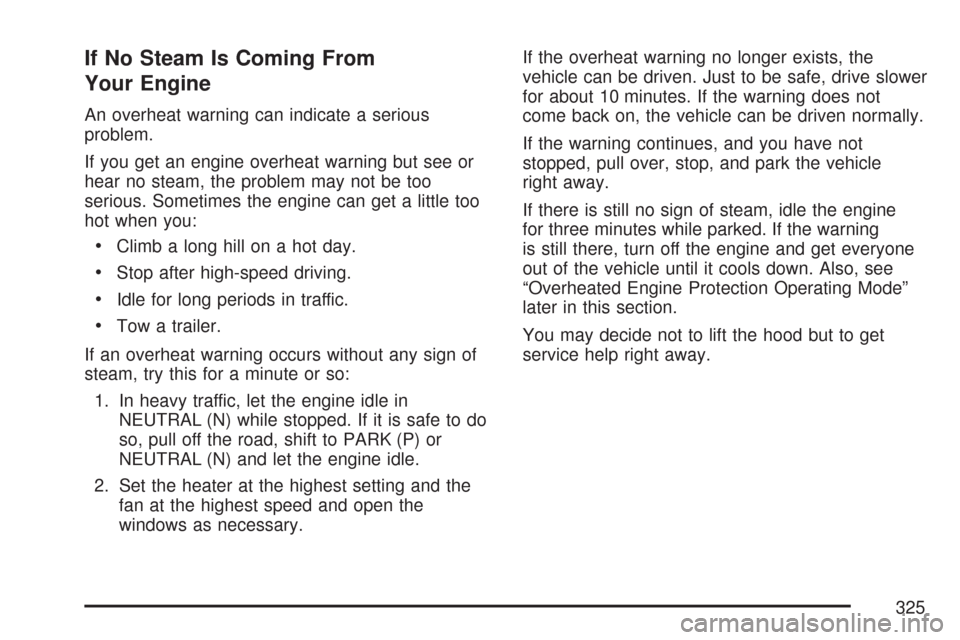
If No Steam Is Coming From
Your Engine
An overheat warning can indicate a serious
problem.
If you get an engine overheat warning but see or
hear no steam, the problem may not be too
serious. Sometimes the engine can get a little too
hot when you:
Climb a long hill on a hot day.
Stop after high-speed driving.
Idle for long periods in traffic.
Tow a trailer.
If an overheat warning occurs without any sign of
steam, try this for a minute or so:
1. In heavy traffic, let the engine idle in
NEUTRAL (N) while stopped. If it is safe to do
so, pull off the road, shift to PARK (P) or
NEUTRAL (N) and let the engine idle.
2. Set the heater at the highest setting and the
fan at the highest speed and open the
windows as necessary.If the overheat warning no longer exists, the
vehicle can be driven. Just to be safe, drive slower
for about 10 minutes. If the warning does not
come back on, the vehicle can be driven normally.
If the warning continues, and you have not
stopped, pull over, stop, and park the vehicle
right away.
If there is still no sign of steam, idle the engine
for three minutes while parked. If the warning
is still there, turn off the engine and get everyone
out of the vehicle until it cools down. Also, see
“Overheated Engine Protection Operating Mode”
later in this section.
You may decide not to lift the hood but to get
service help right away.
325
Page 326 of 460
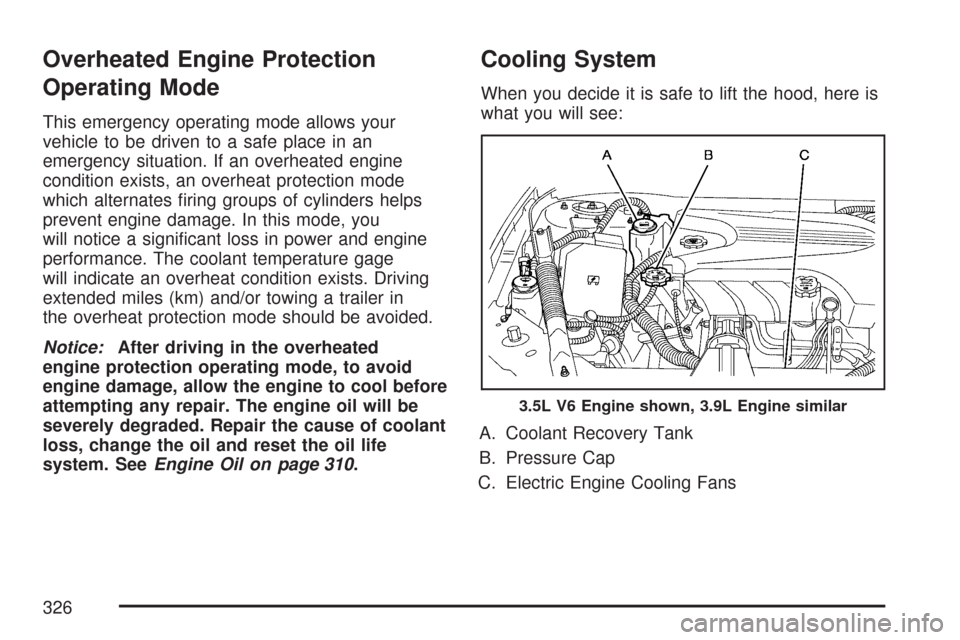
Overheated Engine Protection
Operating Mode
This emergency operating mode allows your
vehicle to be driven to a safe place in an
emergency situation. If an overheated engine
condition exists, an overheat protection mode
which alternates �ring groups of cylinders helps
prevent engine damage. In this mode, you
will notice a signi�cant loss in power and engine
performance. The coolant temperature gage
will indicate an overheat condition exists. Driving
extended miles (km) and/or towing a trailer in
the overheat protection mode should be avoided.
Notice:After driving in the overheated
engine protection operating mode, to avoid
engine damage, allow the engine to cool before
attempting any repair. The engine oil will be
severely degraded. Repair the cause of coolant
loss, change the oil and reset the oil life
system. SeeEngine Oil on page 310.
Cooling System
When you decide it is safe to lift the hood, here is
what you will see:
A. Coolant Recovery Tank
B. Pressure Cap
C. Electric Engine Cooling Fans
3.5L V6 Engine shown, 3.9L Engine similar
326
Page 413 of 460
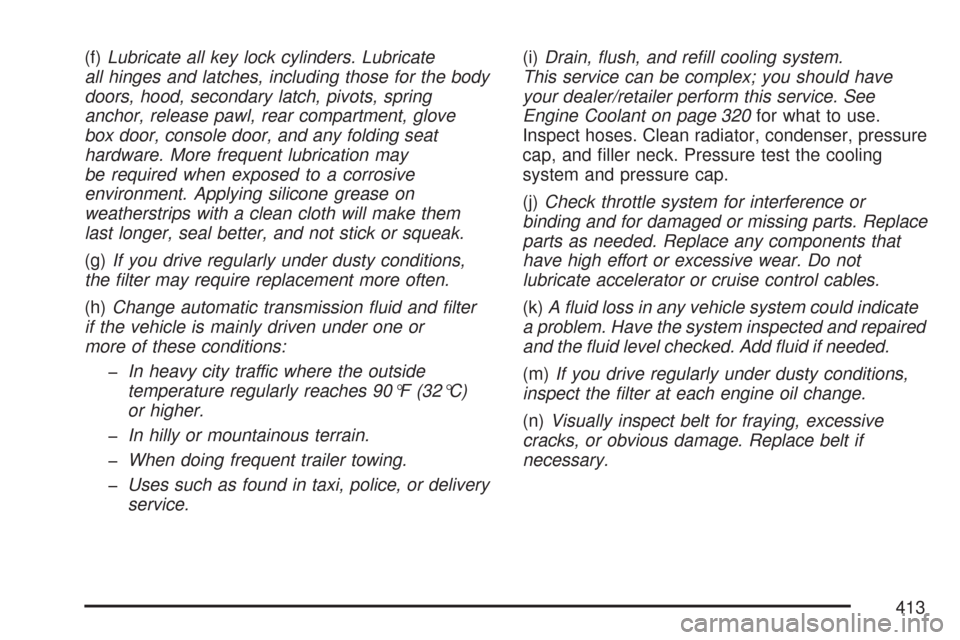
(f)Lubricate all key lock cylinders. Lubricate
all hinges and latches, including those for the body
doors, hood, secondary latch, pivots, spring
anchor, release pawl, rear compartment, glove
box door, console door, and any folding seat
hardware. More frequent lubrication may
be required when exposed to a corrosive
environment. Applying silicone grease on
weatherstrips with a clean cloth will make them
last longer, seal better, and not stick or squeak.
(g)If you drive regularly under dusty conditions,
the �lter may require replacement more often.
(h)Change automatic transmission �uid and �lter
if the vehicle is mainly driven under one or
more of these conditions:
�In heavy city traffic where the outside
temperature regularly reaches 90°F (32°C)
or higher.
�In hilly or mountainous terrain.
�When doing frequent trailer towing.
�Uses such as found in taxi, police, or delivery
service.(i)Drain, �ush, and re�ll cooling system.
This service can be complex; you should have
your dealer/retailer perform this service. See
Engine Coolant on page 320for what to use.
Inspect hoses. Clean radiator, condenser, pressure
cap, and �ller neck. Pressure test the cooling
system and pressure cap.
(j)Check throttle system for interference or
binding and for damaged or missing parts. Replace
parts as needed. Replace any components that
have high effort or excessive wear. Do not
lubricate accelerator or cruise control cables.
(k)A �uid loss in any vehicle system could indicate
a problem. Have the system inspected and repaired
and the �uid level checked. Add �uid if needed.
(m)If you drive regularly under dusty conditions,
inspect the �lter at each engine oil change.
(n)Visually inspect belt for fraying, excessive
cracks, or obvious damage. Replace belt if
necessary.
413
Page 458 of 460
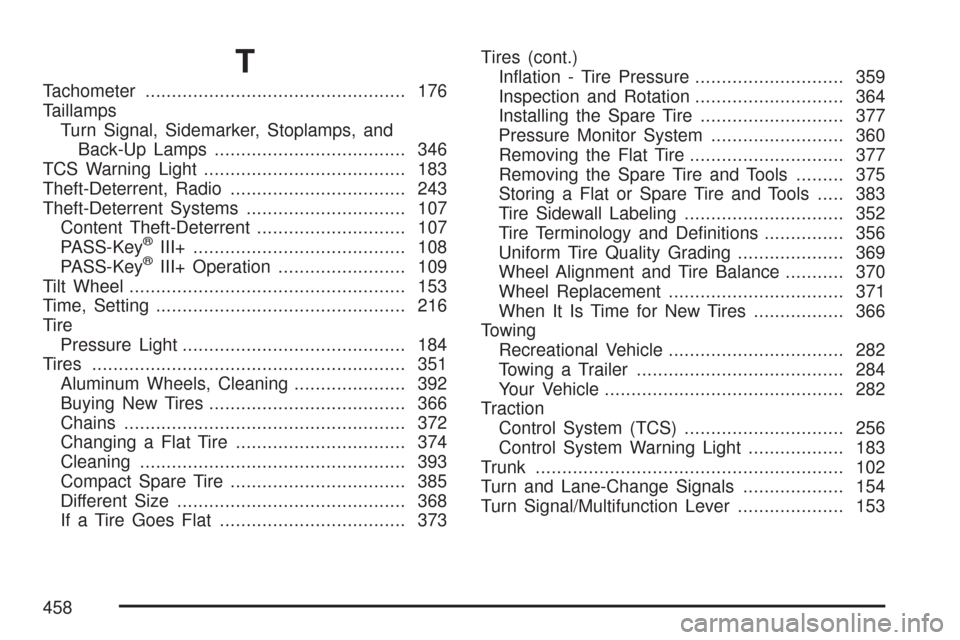
T
Tachometer................................................. 176
Taillamps
Turn Signal, Sidemarker, Stoplamps, and
Back-Up Lamps.................................... 346
TCS Warning Light...................................... 183
Theft-Deterrent, Radio................................. 243
Theft-Deterrent Systems.............................. 107
Content Theft-Deterrent............................ 107
PASS-Key
®III+........................................ 108
PASS-Key®III+ Operation........................ 109
Tilt Wheel.................................................... 153
Time, Setting............................................... 216
Tire
Pressure Light.......................................... 184
Tires........................................................... 351
Aluminum Wheels, Cleaning..................... 392
Buying New Tires..................................... 366
Chains..................................................... 372
Changing a Flat Tire................................ 374
Cleaning.................................................. 393
Compact Spare Tire................................. 385
Different Size........................................... 368
If a Tire Goes Flat................................... 373Tires (cont.)
In�ation - Tire Pressure............................ 359
Inspection and Rotation............................ 364
Installing the Spare Tire........................... 377
Pressure Monitor System ......................... 360
Removing the Flat Tire............................. 377
Removing the Spare Tire and Tools......... 375
Storing a Flat or Spare Tire and Tools..... 383
Tire Sidewall Labeling.............................. 352
Tire Terminology and De�nitions............... 356
Uniform Tire Quality Grading.................... 369
Wheel Alignment and Tire Balance........... 370
Wheel Replacement................................. 371
When It Is Time for New Tires................. 366
Towing
Recreational Vehicle................................. 282
Towing a Trailer....................................... 284
Your Vehicle............................................. 282
Traction
Control System (TCS).............................. 256
Control System Warning Light.................. 183
Trunk.......................................................... 102
Turn and Lane-Change Signals................... 154
Turn Signal/Multifunction Lever.................... 153
458